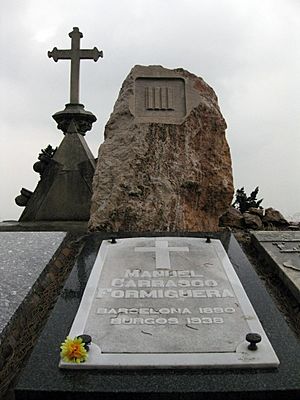Manuel Carrasco Formiguera facts for kids
Manuel Carrasco i Formiguera (born April 3, 1890 – died April 9, 1938) was a Spanish lawyer and politician. He was a Christian democrat and a Catalan nationalist. This means he believed in democratic government based on Christian values and wanted Catalonia to have more self-rule.
Manuel Carrasco's death was ordered by General Francisco Franco. This caused many protests from Catholic journalists around the world. One journalist, Joseph Ageorges, said that Carrasco's death "stained the reputation of Franco." His funeral in Paris on April 27, 1938, was attended by many famous people, including the artist Joan Miró.
Contents
Early Life
Manuel Carrasco was born in Barcelona, Spain. In 1912, he was studying law at the Complutense University of Madrid. During this time, he joined a Catholic youth group.
He became a city councilor in Barcelona in 1920. In 1922, he helped start a political group called Acció Catalana. He also created a nationalist newspaper called L'Estevet. This newspaper often criticized the Spanish army. Because of his strong nationalist views, Carrasco was put on trial several times. He was even sentenced to six months in prison for cartoons in his newspaper.
Even though it was his first offense, he had to serve his full sentence in harsh conditions. This happened because a new dictator, Miguel Primo de Rivera, took power. Carrasco was known for his strong belief in Catalan nationalism. But he always believed in following the law and rejected violence. This was different from some other Catalan leaders who were ready for armed struggle.
Second Spanish Republic
In 1930, Carrasco helped sign the Pact of San Sebastian. This was an agreement by different groups to bring about a new republic in Spain.
When the Second Spanish Republic was declared in 1931, he became the Minister of Health and Welfare. This was in the first government of Catalonia, led by Francesc Macià. A few months later, in June 1931, he was elected as a representative for Girona. He strongly defended the rights of the Catholic Church and religious groups. He also supported the Statute of Núria, which gave Catalonia more self-governance.
In 1932, he left Acció Catalana and joined a new group called the Democratic Union of Catalonia. He quickly became one of its main leaders.
Spanish Civil War
When the Spanish Civil War began in 1936, Carrasco remained loyal to the Republic. He helped many people who were being persecuted. However, these actions also made him a target. Some anarchist and communist groups in Catalonia harassed him.
He worked in the Catalan finance ministry until December 1936. But after a newspaper criticized him, he had to move to the Basque Country. There, he worked with the Basque government. After a mission in Bilbao, he returned to Barcelona. But he found out that some people still wanted to harm him.
So, he decided to leave again with his family. He was going to represent the Catalan government with the Basque government. They sailed from Bayonne to Bilbao on a ship called the Galdames. Carrasco admired the Basques because they protected the Church and avoided religious persecution.
However, a ship from Franco's side, the Canarias, stopped their freighter. Carrasco and his family were taken to Pasajes. His family was separated. His two older daughters were jailed, and his three younger children were put in an asylum. Carrasco, his wife, and their baby daughter were taken to Burgos.
In August 1937, the International Red Cross helped arrange an exchange. Carrasco's family was exchanged for the family of a general from Franco's side. His family was able to move to Paris.
Carrasco was moved to a prison in Burgos. He was sentenced to death in a quick trial on August 28, 1937. He was accused of being against Franco's government. Many people, including Cardinal Francisco Vidal y Barraquer and Cardinal Eugenio Pacelli (who later became Pope Pius XII), tried to save him. They said Carrasco was a good Catholic who always defended the Church. But all efforts to save him failed.
Death and Legacy

Manuel Carrasco's execution was delayed for eight months. It finally happened on April 9, 1938, in Burgos. This was despite the Vatican's efforts to stop it. Franco personally approved the execution.
In his final hours, Carrasco was with his friend, Father Ignacio Romana. Father Romana urged him to give up his Catalan beliefs and support Franco to save his life. But Carrasco refused. He wrote two letters: one to his wife and one to the President of Catalonia, Lluís Companys. He asked that his death not be used as an excuse for revenge. He also asked for his diary to be given to his wife, but this promise was not kept.
When he reached the execution spot, Carrasco carried a crucifix and a small wool shoe belonging to his baby daughter. He refused a blindfold. His last words were, "Long Live free Catalonia!" He also said, "Jesus, Jesus!" before he was shot.
Many believe Franco ordered Carrasco's execution because foreign governments, including the Vatican, protested against Franco's bombing of cities like Barcelona.
On September 25, 2005, the Spanish Congress of Deputies agreed to cancel the court martial that had condemned Carrasco. This officially recognized the injustice of his trial.
External sources
- Carrasco i Formiguera: la defensa de la fe y del país hasta la muerte no conoce ideologías políticas, en catholic.net
- Diario de sesiones del Congreso de los Diputados de 27 de septiembre de 2005, en la que se debatió y aprobó la proposición no de ley de CiU para la anulación del consejo de guerra en el que se condenó a Carrasco i Formiguera.
See also
 In Spanish: Manuel Carrasco Formiguera para niños
In Spanish: Manuel Carrasco Formiguera para niños

